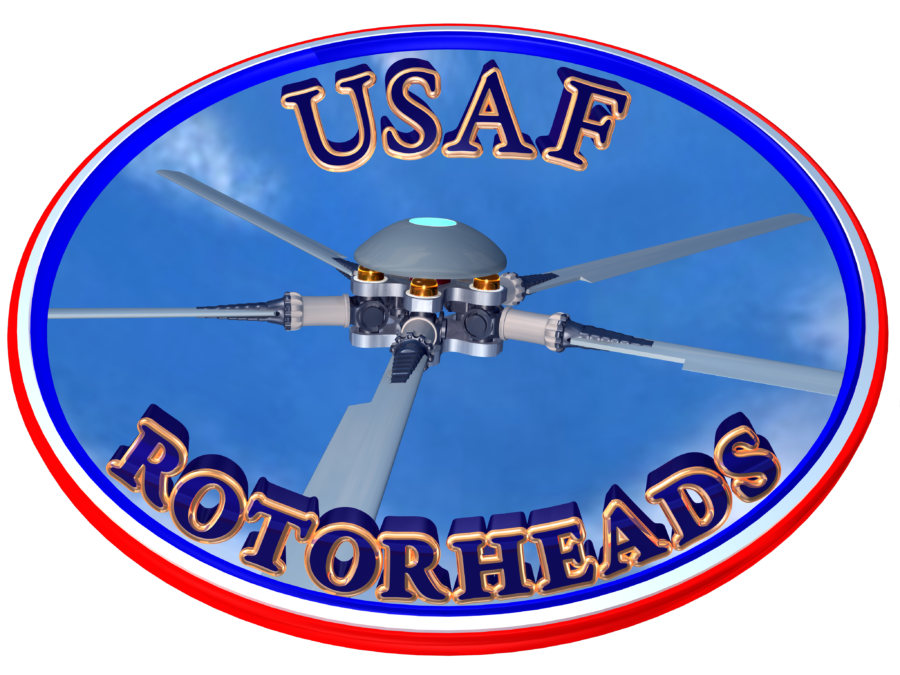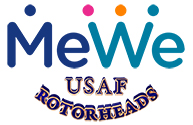Awards
Medal of Honor and Silver Star sections complete. Other medal section is partially complete.
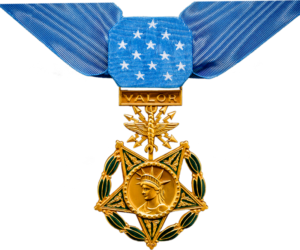
The Medal of Honor is the highest award for valor in action against an enemy force which can be bestowed upon an individual serving in the Armed Services of the United States. Generally presented to its recipient by the President of the United States of America in the name of Congress, it is often called the Congressional Medal of Honor.
Authorized in 1956, the Air Force unveiled its own design for the Medal of Honor in 1965. About 50% larger than the other services' Medals of Honor, it retained the laurel wreath and oak leaves of the Army Medal which had previously been presented to members of the Army Air Service and Air Corps. It also retained the bar bearing the word "VALOR". Inside the circle of stars the helmeted profile of Minerva from the Army's medal is replaced by the head of the Statue of Liberty. Replacing the Army's eagle is the Air Force Coat of Arms.
Since the formation of a separate Air Force in 1947 there have been seventeen recipients. Prior to 1963 members of the Army Air Corps and the Air Force were awarded the Army Medal. In 1963 the Air Force acquired its own MOH design. There were thirteen recipients in Vietnam.
It is bestowed "for conspicuous gallantry and intrepidity at the risk of life, above and beyond the call of duty, in actual combat against an armed enemy force."
There were three Air Rescue and Special Operations recipients during the Vietnam War.

The Air Force Cross was originally established by Act of Congress (Public Law 193, 65th Congress approved July 9, 1918) as the Distinguished Service Cross. Public Law 86-593, approved by Congress on July 6, 1960, amended Title 10 of the United States Code by authorizing the Air Force to present a distinctive version of the Distinguished Service Cross to Air Force recipients.
The Air Force Cross is the second highest decoration awarded by the Air Force and is given for extraordinary heroism not justifying the award of a Medal of Honor. It may be awarded to any person who, while serving in any capacity with the U.S. Air Force, distinguishes himself by extraordinary heroism (1) in action against an enemy of the United States; (2) while engaged in military operations involving conflict with an opposing foreign force; or, (3) while serving with friendly foreign forces engaged in an armed conflict against an opposing armed force in which the United States is not a belligerent party. Like the Distinguished Service Cross, the Air Force Cross is presented in the name of the President, although the Air Force itself actually controls this award.
The Air Force Cross has been award to the following Air Rescue and Special Operations helicopter personnel:
"Global War on Terror (Afghanistan)"
*CHAPMAN, JOHN A. Technical Sergeant, U.S. Air Force, 24th Special Tactics Squadron, Date of Action: March 4, 2002.
*CUNNINGHAM, JASON D. Senior Airman, U.S. Air Force, 38th Rescue Squadron, Quick Reaction Force, Date of Action: March 4, 2002.
"Somalia"
WILKINSON, TIMOTHY A. Technical Sergeant, U. S. Air Force, 24th Special Tactics Squadron, Date of action: October 3-4, 1993.
"Mayaguez Incident"
BACKLUND, DONALD R. First Lieutenant, U.S. Air Force, 40th ARRS, Date of Action: May 15, 1975
BRIMS, RICHARD C. First Lieutenant, U.S. Air Force, 21st SOS, Date of Action: May 15, 1975
HARSTON, JON D. Staff Sergeant, U.S. Air Force, 21st SOS, Date of Action: May 15, 1975
PURSER, ROWLAND W. Captain, U.S. Air Force, 40th ARRS, Date of Action: May 15, 1975
"Southeast Asia (SEA)"
ADAMS, VICTOR R. Technical Sergeant, U.S. Air Force, 20th Special Operations Squadron, Date of Action: November 27, 1968
ALLISON, JOHN V. Lieutenant Colonel, U.S. Air Force, 40th Aerospace Rescue and Recovery Squadron, 3d Aerospace Rescue and Recovery Group, Date of Action: November 21, 1970
*BALDWIN, ROBERT LANOUE Major, U.S. Air Force, E Flight, 20th Special Operations Squadron, 14th Special Operations Wing, in action in the Republic of Vietnam, Date of Action: March 31, 1967
BLACK, ARTHUR NEIL (POW) Airman Third Class, U.S. Air Force, Detachment 3, 38th Aerospace Rescue and Recovery Squadron, Tan Son Nhut Air Base, Vietnam, Date of Action: September 20, 1965
BRITTON, WARNER A. Colonel, U.S. Air Force, Date of Action: November 21, 1970
*BROWER, RALPH WAYNE (MIA) Captain, U.S. Air Force, 37th Aerospace Rescue and Recovery Squadron, Da Nang Air Base, Vietnam, Date of Action: November 09, 1967
*CLAY, EUGENE LUNSFORD Staff Sergeant, U.S. Air Force, 37th Aerospace Rescue and Recovery Squadron, Da Nang Air Base, Vietnam, Date of Action: November 09, 1967
CONRAN, PHILIP J. Major, U.S. Air Force, 21st Special Operations Squadron, 56th Special Operations Wing, Nakhon Phanom Royal Thai Air Base, Thailand, Date of Action: October 06, 1969
CURTIS, THOMAS JERRY (POW) Captain, U.S. Air Force, Detachment 3, 38th Aerospace Rescue and Recovery Squadron, Tan Son Nhut Air Base, Vietnam, Date of Action: September 20, 1965
DONOHUE, FREDERIC M. Major, U.S. Air Force, Date of Action: November 21, 1970
EPPINGER, DALE Major, U.S. Air Force, 20th Special Operations Squadron, Nha Trang Air Base, Vietnam, Date of Action: April 21, 1969
ETZEL, GREGORY A. M. Captain, U.S. Air Force, 37th Aerospace Rescue and Recovery Squadron, 3d Air Rescue and Recovery Group, Da Nang Air Base, Vietnam, Date of Action: July 2 & 3, 1967
FIRSE, JOHN A. Captain, U.S. Air Force, Detachment 5, 38th Aerospace Rescue and Recovery Squadron, Udorn Royal Thai Air Base, Thailand, Date of Action: June 11, 1967
FISH, MICHAEL E. Sergeant, U.S. Air Force, 38th Aerospace Rescue and Recovery Squadron, Tan Son Nhut Air Base, Vietnam, Date of Action: February 18 & 19, 1969
GONZALES, LEONARD A. Major, U.S. Air Force, 20th Special Operations Squadron, Nha Trang Air Base, Vietnam, Date of Action: November 26, 1968
GREEN, JOE B. Major, U.S. Air Force, 37th Aerospace Rescue and Recovery Squadron, 3d Air Rescue and Recovery Group, Da Nang Air Base, Vietnam, Date of Action: March 30, 1968
GRIGGS, JERRY M. Major, U.S. Air Force, 37th Aerospace Rescue and Recovery Squadron, 3d Air Rescue and Recovery Group, Da Nang Air Base, Vietnam, Date of Action: March 30, 1968
GRUVER, JOHN C. Captain, U.S. Air Force, 20th Special Operations Squadron, Nha Trang Air Base, Vietnam, Date of Action: March 21, 1967
HACKNEY, DUANE D. Airman Second Class, U.S. Air Force, 37th Aerospace Rescue and Recovery Squadron, Da Nang Air Base, Vietnam, Date of Action: February 06, 1967
HUNT, RUSSELL M. Sergeant, U.S. Air Force, E Flight, 20th Special Operations Squadron, 14th Special Operations Wing, in action in the Republic of Vietnam, Date of Action: March 31, 1967
KALEN, HERBERT D. Major, U.S. Air Force, Date of Action: November 21, 1970
KENNEDY, LELAND T. (First Award) Captain, U.S. Air Force, Detachment 5, 38th Aerospace Rescue and Recovery Squadron, Da Nang Air Base, Vietnam, Date of Action: October 05, 1966
KENNEDY, LELAND T. (Second Award) Captain, U.S. Air Force, 38th Aerospace Rescue and Recovery Squadron, Da Nang Air Base, Vietnam, Date of Action: October 20, 1966 (AF Magazine)
*KING, CHARLES DOUGLAS (MIA) Airman First Class, U.S. Air Force, 40th Aerospace Rescue and Recovery Squadron, Nakhon Phanom Royal Thai Air Base, Thailand, Date of Action: December 25, 1968
*MARTIN, DUANE WHITNEY (POW/Died while attempting to escape) First Lieutenant, U.S. Air Force, Detachment 3, 38th Aerospace Rescue and Recovery Squadron, Tan Son Nhut Air Base, Vietnam, Date of Action: September 20, 1965
*MAYSEY, LARRY WAYNE (MIA) Sergeant, U.S. Air Force,37th Aerospace Rescue and Recovery Squadron, Da Nang Air Base, Vietnam, Date of Action: November 09, 1967
McGRATH, CHARLES D. Sergeant, U.S. Air Force, 40th Aerospace Rescue and Recovery Squadron, Nakhon Phanom Royal Thai Air Base, Thailand, Date of Action: June 27, 1972
McTASNEY, JOHN B. Captain, U.S. Air Force, 37th Aerospace Rescue and Recovery Squadron, Da Nang Air Base, Vietnam, Date of Action: November 8, 1967
NEWMAN, THOMAS A. Sergeant, U.S. Air Force, 40th Aerospace Rescue and Recovery Squadron, Nakhon Phanom Royal Thai Air Base, Thailand, Date of Action: May 30, 1968
O'MARA, OLIVER E. Lieutenant Colonel, U.S. Air Force, 38th Aerospace Rescue and Recovery Squadron, Da Nang Air Base, Vietnam, Date of Action: October 05, 1966. Read a great story of this gentleman's service to his country.
OLSEN, DON P. Major, U.S. Air Force, 37th Aerospace Rescue and Recovery Squadron, 3d Air Rescue and Recovery Group, Da Nang Air Base, Vietnam, Date of Action: October 5, 1968
ORRELL, BENNIE D. Captain, U.S. Air Force, 40th Aerospace Rescue and Recovery Squadron, Nakhon Phanom Royal Thai Air Base, Thailand, Date of Action: April 13, 1972
RICHARDSON, DENNIS M. Sgt, U.S. Air Force, Date of Action: March 14, 1968. (CMSgt Retired Richardson was awarded The Air Force Cross on April 5, 2008)
ROBINSON, WILLIAM ANDREW (POW) Airman First Class, U.S. Air Force, Detachment 3, 38th Aerospace Rescue and Recovery Squadron, Tan Son Nhut Air Base, Vietnam, Date of Action: September 20, 1965
*SCHANEBERG, LEROY CLYDE (MIA) Captain, U.S. Air Force, 40th Aerospace Rescue & Recovery Squadron, Udorn Air Royal Thai Air Base, Thailand, Date of Action: June 30, 1970
*SCOTT, TRAVIS HENRY, JR. Captain, U.S. Air Force, 37th Aerospace Rescue and Recovery Squadron, Da Nang Air Base, Vietnam, Date of Action: April 15, 1970
SMITH, DONALD G. Technical Sergeant, U.S. Air Force, 37th Aerospace Rescue and Recovery Squadron, Da Nang Air Base, Vietnam, Date of Action: October 24, 1969
STOVALL, DALE E. Captain, U.S. Air Force, 40th Aerospace Rescue and Recovery Squadron, Nakhon Phanom Royal Thai Air Base, Thailand, Date of Action: June 1 - 2, 1972
TALLEY, JOEL E. Airman, U.S. Air Force, 37th Aerospace Rescue and Recovery Squadron, Da Nang Air Base, Vietnam, Date of Action: July 02, 1968
WOFFORD, TRAVIS Major, U.S. Air Force, 37th Aerospace Rescue and Recovery Squadron, 3d Air Rescue and Recovery Group, Da Nang Air Base, Vietnam, Date of Action: April 15, 1970
*WOOD, PATRICK HARDY (MIA) Major, U.S. Air Force, 38th Aerospace Rescue and Recovery Squadron, Tan Son Nhut Air Base, Vietnam, Date of Action: February 06, 1967
WRIGHT, LEROY Technical Sergeant, U.S. Air Force, Date of Action: November 21, 1970
YORK, GLEN P. Major, U.S. Air Force, Date of Action: July 18, 1967
*Indicates Posthumous Awards (Also includes recipients KIA after their AFC Award)
NOTE: The AFC originally awarded Airman 1/c William Pitsenbarger was upgraded to the Medal of Honor on Dec 8, 2000. That AFC is not included in this list.
NOTE: Dennis M. Richardson was awarded the Air Force Cross on 5 April 2008, 40 years after the fact.
This section is for those members who desire to document their stories that support the various decorations they were presented by our Government as recognition for a job well done. Sharing of these stories will document for later generations to read and understand what it was like during those times and the routine tasks that often were not routine. In reality one would have had to been there to fully understand.
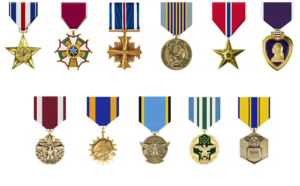
James (J.D.) Adams
Jim Burns
Jim Moore
John Lindgren
Ralph Graves
Cheney Award

The Cheney Award is an aviation award presented by the United States Air Force in memory of 1st Lt. William Cheney, who was killed in an air collision over Italy in 1918. It was established in 1927, and is awarded to an airman for an act of valor, extreme fortitude or self-sacrifice in a humanitarian interest, performed in connection with aircraft, but not necessarily of a military nature. The award consists of a certificate, a bronze statue and a $500 honorarium.
Listed below are USAF helicopter personnel known to have been awarded the coveted award. If you know of others receiving this award along with the mission specifics, please contact us.
~2011~
Rescue crew members receive Cheney Award
by Senior Airman Christina Brownlow, Air Force Public Affairs Agency
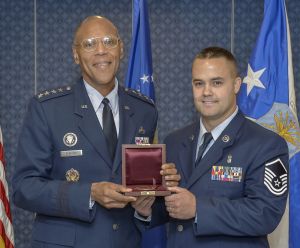 |
 |
| Air Force Vice Chief of Staff Gen. Larry Spencer presents the 2011 Cheney Award to Master Sgt. Joseph Brownell during a ceremony at the Pentagon on Nov. 1, 2012. Brownell earned the award for a harrowing rescue mission to extract a medically distressed civilian hiker and his son from the Cascade Mountains of Washington state. (U.S. Air Force photo/Michael J. Pausic) | Air Force Vice Chief of Staff Gen. Larry Spencer presents the 2011 Cheney Award to Capt. Kenneth Green during a ceremony at the Pentagon on Nov. 1, 2012. Established in 1927, the Cheney Award is awarded to Airmen for an act of valor, extreme fortitude or self-sacrifice in a humanitarian interest, performed with an aircraft. (U.S. Air Force photo/Michael J. Pausic) |
11/6/2012 - WASHINGTON (AFNS) -- Two Airmen received the 2011 Cheney Award here Nov. 1 from Air Force Vice Chief of Staff Gen. Larry Spencer for their distinguished service during a search and rescue mission on Mount Stuart, Wash.
Capt. Kenneth Green, UH-1N Twin Huey pilot, and Master Sgt. Joseph Brownell, field operation section chief, saved the lives of a civilian and his son Aug. 20, 2011, after they suffered acute mountain sickness while climbing the mountain's 9,000-foot peak.
Green executed a 200-foot hover and hoisted Brownell down to access the climbers. Brownell then stabilized both people and extracted them by hoist. Near maximum weight, the aircraft then began to descend, so Green expertly maneuvered the aircraft to lower terrain.
"The mission called and these two gentlemen launched," Spencer said. "When the mission calls, (Airmen) don't stop and ask questions. We just go rely on the training we have received."
The Cheney Award honors an Air Force member for an act of valor, extreme fortitude or self-sacrifice in a humanitarian interest, performed in connection with aircraft, but not necessarily of a military nature. It is presented in memory of 1st Lt. William Cheney, who was killed in an air collision over Italy in 1918.
"There are heroic things going on in our Air Force every day, and these two gentlemen epitomize that," Spencer said.
Both Airmen said they were humbled and honored to receive the award, and said the mission would not have been a success without the dedication of everyone involved.
Green credited his Air Force training for ensuring he and other Airmen can continue to ably serve the nation.
Brownell was quick to point out that many other Airmen helped them the day of the rescue, not to mention the two other crew members on the mission.
"We are truly a team -- everybody from the maintainers who maintain the helicopter to the guys flying," he said. "We can't do it without them."
~2009~

Air Force Chief of Staff Gen. Norton Schwartz presents Maj. John Mangan with the Cheney Award Oct. 15, 2010, at the Pentagon. Major Mangan received the award for his actions as the pilot of an HH-60 Pave Hawk on a rescue mission in Afghanistan. Under intense enemy fire, Major Mangan managed to land and save the lives of two critically injured Marines without ground communications or airborne support. The Cheney Award is presented each year to aviators who demonstrate an act of valor, extreme fortitude or self-sacrifice in a humanitarian venture. Major Mangan is currently assigned to Nellis Air Force Base, Nev. (U.S. Air Force photo)
Helicopter pilot receives Cheney Award
by Tech. Sgt. Amaani Lyle,
Secretary of the Air Force Public Affairs
12/7/2010 -WASHINGTON (AFNS)
An HH-60G helicopter pilot received the Cheney Award from Air Force Chief of Staff Gen. Norton Schwartz here Oct. 15 for the rescue of two critically injured Marines in Helmand Valley, Afghanistan.
Maj. John G. Mangan, the assistant director of operations for the 41st Rescue Squadron at Moody Air Force Base, Ga., led his formation of two HH-60Gs on July 2, 2009, while in support of Operation Enduring Freedom.
According to his citation, Maj. Mangan executed multiple approaches into two different landing zones despite intense enemy fire and a lack of communications with ground forces.

"We were holding a few miles away trying to make contact with the ground commander while enemy forces were within 300 meters to the west, north and south," Major Mangan said. "It was a difficult situation and a lucky decision, but I said to myself, 'we're not gonna call it quits,' knowing people's lives were on the line."
During the rescue, his wingman's aircraft took enemy fire, causing Major Mangan to execute the final phase of the rescue without airborne mutual support.
"My wingman almost got shot down altogether; a bullet passed a couple of feet away from his head," the major said. "He flew away to assess the damage on his aircraft, and once he realized it was still battle-worthy, he returned to continue the fight and assist in the rescue."
Though the major's decisions as he engaged enemy forces saved the lives of two Marines, he credits his team for completing the daunting mission.
"There were 15 people on the flight who put their lives at risk to do the right thing and save these guys; it wasn't just me," the major said. "Each one of them was absolutely critical for the mission to be successful."
~2004~
 An Air Force MH-53 Pave Low helicopter pilot from Fort Bragg, N.C., received the Cheney Award in a ceremony at the Pentagon Oct. 13. Maj. John Groves earned the award for his actions while delivering supplies to Iraq as part of two-ship formation. The major’s wingman was shot down en-route.
An Air Force MH-53 Pave Low helicopter pilot from Fort Bragg, N.C., received the Cheney Award in a ceremony at the Pentagon Oct. 13. Maj. John Groves earned the award for his actions while delivering supplies to Iraq as part of two-ship formation. The major’s wingman was shot down en-route.
Major Groves, while under fire, found and rescued the other aircrew “Right after they were shot down, we didn’t know where they were,” the major said. “The rest of my crew kept cool heads and we made the decision to get down and rescue the other crew.
”During the rescue, Major Groves and his crew continued to fend off enemy attacks. “It shows
that we’ll do whatever it takes to bring our folks home,” Major Groves said. Air Force Chief of Staff Gen. T. Michael Moseley and acting Secretary of the Air Force Pete Geren presented Major Groves with the Cheney medallion. The major was accompanied by several family members.
“It’s an honor and a privilege to be able to give this to you for this act of heroism,” General Moseley told Major Groves. “You represent the finest traditions of this service.”
~2003~
For the second straight year, Airmen from the 21st Special Operations Squadron at Royal Air Force Mildenhall, England, have earned the Cheney Award for aerial achievement.
Capt's. (then 1st. Lt.) Randell Voas and Craig Prather earned the award for their role in the March 26, 2003, air drop mission of the U.S. Army’s 173rd Airborne Brigade over Bashur in northern Iraq.
The mission was the largest combat air drop since the Vietnam War. “These two took their (MH-53M Pave Low) helicopter from Greece, flew almost 700 miles to the drop area,” said Air Force Chief of Staff Gen. John P. Jumper. As part of a 1,000-Soldier airdrop mission, the crew provided on-call fire support, immediate casualty evacuation, triage and recovery for 37 paratroopers.
The flight was conducted at maximum wartime weight in deteriorating weather and included three aerial refueling's. “Guys like this think these things are routine, but to those of us who don’t live that life, it is very special indeed,” General Jumper said. “It is a mark of our Air Force that we have officers of this caliber who are.”
~2002~
 An officer from the 58th Special Operations Wing won the 2002 Cheney Award for saving two critically injured crew members of the yacht, the Persuader, when he was stationed in England.
An officer from the 58th Special Operations Wing won the 2002 Cheney Award for saving two critically injured crew members of the yacht, the Persuader, when he was stationed in England.
Maj. Kevin Churchill, now the 551st Special Operations Squadron’s executive officer, and Capt. Sean Leroy from Mildenhall Air Base, England, responded to an ocean rescue on May 21, 2002.
“We were preparing to fly training lines that night,” Churchill said. “I was on the hover pad performing hover checks and Leroy had just gotten in to his seat running the checklist on his aircraft when the 21st Special Operations Squadron asked us to shut down and come inside for a possible rescue mission.”
Both the pilots planned and executed the 11-hour mission consisting of two MH-53M helicopters, two British Nimrod Surveillance aircraft, two MC-130P refueling tankers, one KC-135 tanker, two international freighters and three pararescue teams. It turned out to be the longest non-stopover water rescue launched from the British island in the last 12 years.
“The yacht was somewhere between 450 and 500 nautical miles off the southwest tip of England and had been rolled over by a wave,” Churchill said. “On deck, a civilian sailor had been washed overboard and nearly drowned. Beneath the deck, the ship’s cook was buried under various equipment and suffered a broken collarbone, among other injuries. Both sailors appeared to have undetermined head injuries.
”The rescue unit out of Keflavik Naval Air Station, Iceland, had been notified but was more than 900 nautical miles away. Since the RAF does not maintain aerial refueling helicopters or tankers, the yacht would not be in its range for at least two more days.
“Since the true extent of the injuries was not known, it was imperative that we launch to recover the sailors immediately, knowing that even with our capabilities, we were nearly six hours away,” said the major.
Gen. Michael Moseley, Air Force vice chief of staff, gave Churchill and Leroy the award at the Pentagon in August. Secretary of the Air Force James Roche attended.
“Overall, just an awe-inspiring event,” Churchill said. “To be in front of a group of people I have long respected and admired for their own actions in various operations throughout the world and to be recognized in this manner was truly something very special for me. Especially since my mother, wife and children were able to be there. It was very humbling to realize that, though I was one of 22 men on for that mission on that night, it was the sacrifices of my family during all those long TDYs and all those late training nights that prepared me to be there.”
~1996~
Major Brad Webb, "Pave Low" pilot and designated "Pave Low" team leader, was awarded the 1996 Cheney Award for his sterling performance in the back-to-back CT-43 crash recovery effort in Croatia 03-06 April 1996 and his leadership and participation in the "Operation Assured Response" mission in which his "Pave Low" teams, along with other JSOAC forced evacuated 2,126 people from 76 countries from the fighting that was taking place in Monrovia, Liberia, 08-17 April 1996.
~1995~
MH-53 pilots Capt. Charles (Mark) Harmon and Captain Charles (Mike) M. Moncrief and crews of "Knife 44" and "Knife 47" entered Bosnia, on 6 September 1995, in the dark of night and at low level, utilizing the Pave enhanced navigation capability and the crew's night vision goggles attempting to rescue the crew of a French Mirage 2000K (Call sign "Ebro 33") that shot down on the morning of 30 August 1995. The French crewmen were not located. These same MH-53 Pave Lows again entered Bosnia on 7 September 1995 in a second attempt to recover the crew of "Ebro 33" and both aircraft received damage from enemy ground fire and again, the crew of "Ebro 33" could not be located. Captain Harmon and Captain Moncrief were dually awarded the 1995 Cheney Award for their outstanding leadership of the mission.
~1994~
Two HH-60G crews (Call sign "Rescue 206 & 208") from the 56th RQS at NAS Keflavik, Island received the 1994 Cheney Award for their January 10-11, 1994 rescue of six Icelanders from their sunken rescue tug, just off the coast of Vodvlavik, Iceland. This rescue was accomplished at night during extremely bad weather conditions. Crew members known to be involved in this mission include Lt. Col. Jim Sills (P), Capt. Gary Copsey (CP), Capt. John Blumintritt (P), Capt. Gary Henderson (CP), USN Flight Surgeon Lt. Rich Assaf (FS), Sr. Amn. Jeff Frembling (FE), A1C Bill Payne (FE), Sr. Amn. Jesse Goerz (PJ) and Sr. Amn. Matt Wells (PJ).
~1993~
Colonel Russell and Major John Brainerd, of the 21st SOS, were awarded the Cheney Award for the actions of their Pave Low crews on 5 January 1993 to recover an injured French officer from Zakho, Iraq. The flew their aircraft into northern Iraq at night in snowstorms and icing conditions and receiving enemy ground fire to recover the injured French officer and deliver him to critically needed medical care at Incirlik AB.
~1992~
 Major Richard McNabb of Erwin and members of his family visited Congressman James H. Quillen's Washington office last week after McNabb, an Air Force helicopter pilot, was presented the 1992 Cheney Award at the Pentagon for valor and courage in the successful search and rescue of a Turkish pilot downed in the UN Exclusion Zone of Iraq last July 1-3.
Major Richard McNabb of Erwin and members of his family visited Congressman James H. Quillen's Washington office last week after McNabb, an Air Force helicopter pilot, was presented the 1992 Cheney Award at the Pentagon for valor and courage in the successful search and rescue of a Turkish pilot downed in the UN Exclusion Zone of Iraq last July 1-3.
McNabb was nominated by Quillen to attend the U.S. Air Force Academy in 1976. On hand for the occasion were McNabb's wife, Julia; their three children, Shawn, Krista, and Cameron; his parents, Mr. and Mrs. Robert McNabb.
In addition to the Cheney Award, McNabb holds the Meritorious Service Medal with one oak leaf cluster, the Air Force Medal and the Aerial Achievement Medal.
~1985~
Major Larry Clemons, who was also a recipient of the Distinguished Flying Cross in Vietnam, “…distinguished himself by performing a conspicuous act of valor during an aerial flight on 7 January 1985, while assigned to the 6594th Test Group, Hickam Air Force Base, Hawaii. Major Clemons’ outstanding skill and leadership as aircraft commander of an HH-53 aircraft resulted in the rescue of a seriously ill crew member aboard the vessel “Queen Victoria.” The 1,380-mile flight established a new world record for the longest overwater helicopter rescue without landing. The professional competence, aerial skill, and outstanding leadership displayed by Major Clemons reflect great credit upon himself and the United States Air Force.”
~1979~
 An aerial rescue mission from a burning hotel in Spain has earned an Aerospace Rescue and Recovery Service helicopter pilot and Pararescueman the 1979 Cheney Award.
An aerial rescue mission from a burning hotel in Spain has earned an Aerospace Rescue and Recovery Service helicopter pilot and Pararescueman the 1979 Cheney Award.
The award was presented to Capt. Kenneth R. Rees Jr. and Tech. Sgt. John L. Pighini by Air Force Chief of Staff Gen. Lew Allen Jr. in a Pentagon ceremony August 7.
The Cheney Award recognizes an “act of valor, extreme fortitude, or self-sacrifice in a humanitarian interest performed in connection with aircraft.”
Early on the morning of July 12, 1979, Spain’s largest hotel, the Cornoa De Aragon, in Zaragoza caught fire. The fire quickly spread throughout the ten-story building…stranding many guests and employees on the top floors, well out of reach of local fire-fighting equipment.
Helicopter assistance was requested from Zaragoza AB, and Rees was selected as an aircraft commander, Pighini, who had just completed his physical fitness training, including a four-mile run, volunteered to join him as the Pararescue specialist for the mission.
 Arriving on the scene of the fire, Rees threaded his way through tall buildings and antennas in the area to pick up one survivor and a Pararescueman left by another rescue helicopter. As the survivor and Pararescueman were hoisted into Rees’ helicopter, a man was spotted draped over an eighth floor window sill.
Arriving on the scene of the fire, Rees threaded his way through tall buildings and antennas in the area to pick up one survivor and a Pararescueman left by another rescue helicopter. As the survivor and Pararescueman were hoisted into Rees’ helicopter, a man was spotted draped over an eighth floor window sill.
Despite growing smoke and flames, and updrafts from the fire Pighini volunteered to attempt a rescue. As Rees brought the helicopter to a hover over the hotel, Pighini was lowered by hoist to the eight floor window. Suspended 40 feet below the helicopter, he pulled himself to the window sill using curtains that hung out of the window. Perched on the narrow sill, engulfed in heavy smoke and flames coming out of the window, Pighini strapped the unconscious man to the hoist.
Just as he was ready to signal the helicopter to raise the hoist, a violent updraft swept the helicopter upward. Rees countered with corrective action on the helicopter controls; however, Pighini was swinging on the hoist and smashed into the side of the building.
His flight helmet prevented possible serious head injuries, but his shoulder was injured, and the rescue device was damaged. Rees at this point elected to lower Pighini and the man to a nearby rooftop rather than hoisting them up to the helicopter.
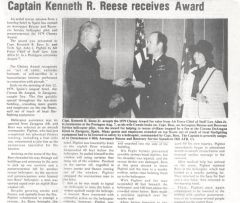 With Pighini and the man suspended 40 feet beneath the helicopter and 100 feet above the crowed street below, Rees made a precision approach over the nearby roof.
With Pighini and the man suspended 40 feet beneath the helicopter and 100 feet above the crowed street below, Rees made a precision approach over the nearby roof.
After being lowered to the nearby rooftop and without regard for his own injuries, Pighini immediately began to administer mouth-to-mouth resuscitation and external cardiac massage to the survivor.
After medical help has arrived on the scene, Pighini rejoined Rees in the helicopter, which had landed at a nearby parking lot. They returned to the base for fuel and a new hoist and then returned to the burning hotel.
There, Pighini once again volunteered to be lowered to the rooftop with another Pararescueman to try to rescue several people trapped on the eighth floor.
 |
 |
 |

~1977~
The 1977 Cheney Award went to SSgt. James T. Carter, a UH-1N crew member from the 20th SOS at Hurlburt Field, FL., for his part in the rescue of a F-4 crew near the burning wreckage of their aircraft, with exploding ordnance, on the Eglin AFB Range.
No other details are known at this time.
~1970~
Major Travis Wofford received the 1970 Cheney Award. Major Travis Wofford and Captain Travis W. Scott, Jr. both won the Air Force Cross during a rescue operation on 15 April 1970, near Dak Nay Puey, Vietnam. Two HH-3E's were scrambled from Da Nang AB, Vietnam, to rescue survivors of a downed UH-1 helicopter. The first HH-3E to go into the rescue area made three attempts, but enemy ground fire downed this aircraft, piloted by Captain Scott, who was killed upon impact. The co-pilot, Major Wofford, dragged the other two crewmen from the burning aircraft. With his bare hands he extinguished the flames still burning on their bodies. The second HH-3E evacuated the survivors of the first HH-3E but was unable to rescue personnel in the downed UH-1 helicopter.
~1969~

USAF Chief of Staff Gen. John C. Ryan Presenting the 1969 Cheney Award to Sgt. Isidro Arroyo Jr.
Air Force Sgt. Isidro Arroyo Jr., 22, of Steamboat Springs, Colo., a weapons instructor at Bien Thuy, Vietnam, has been named 1969 winner of the Cheney Award, Gen. John D. Ryan announced. The award, one the top honors in the Air Force, has been presented annually since 1927 to an airman for "an act of valor, extreme fortitude or self-sacrifice in connection with aircraft."
Arroyo won his award as a result of actions during two helicopters missions in Southeast Asia last year. On both flights the helicopter in which the sergeant served as a gunner was shot down by hostile fire, the Air Force said. In both cases, although injured, he assisted more seriously injured crewmen to rescue helicopters.
Sergeant Isidro Arroyo Jr. was awarded the 1969 Cheney Award for distinguishing himself "on two separate occasions while participating in aerial flights as a UH-1P gunner in Southeast Asia". In February 1969 Sergeant Isidro Arroyo Jr., was a crew member on one of eight Green Hornet Hueys supporting a Special Forces unit in South Vietnam's Central Highlands when word came in that the team was surrounded by enemy troops and involved in a firefight. Two gunships and one Slick headed in to recover the team while the other five choppers stayed out of range. The Huey Arroyo was aboard was hit by small-arms fire, and the fuel tank began to burn. The crew attempted to make a distress call, but a bullet had disabled their radio.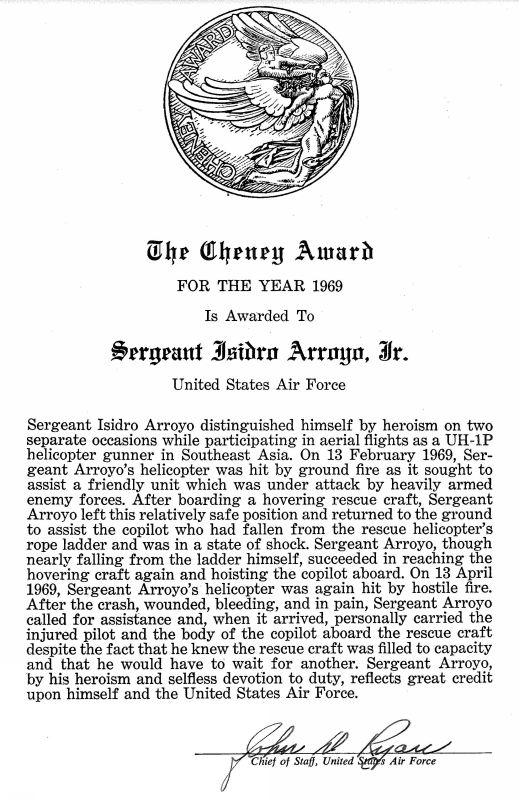
Although the chopper was heavily damaged, the crew managed to make a controlled landing. After they destroyed equipment and data aboard the Huey that might have been used by the enemy, the crewmen made contact with the other Green Hornets via survival radio. Trees around the downed crew's position made it impossible for the other choppers to land. While a rescue helicopter hovered over their position with rope ladders dangling, gunships raked the surrounding trees with mini-gun fire. Sergeant Arroyo was the second man up the ladder, but he went back down again when his co-pilot fell from the ladder and was unable to make the ascent.
Arroyo started back up the ladder, holding onto the co-pilot. With gunfire raging all around them, the co-pilot-who was in shock at that point struggled with the Sergeant trying to help him. When Arroyo had climbed halfway up the ladder, he felt his grip on the co-pilot slipping. The Huey then lowered Arroyo and the co-pilot into a tree, where the sergeant was able to get a better hold on the other man and then managed to hoist him aboard the hovering chopper. Then on April 13, while extracting a recon team, a Green Hornet flight was fired on after it picked up troops. A gunship-flying escort for that extraction mission was hit by ground fire, which killed the co-pilot and seriously wounded the aircraft commander.
Although he was hovering on the verge of unconsciousness due to loss of blood from a wound in his left leg, the pilot managed to land in a nearby clearing. The aircraft came to rest with its tail boom broken and its skids ripped from under it. Aboard serving as gunner was the same Sergeant Arroyo who had been shot down two months earlier. This time, he was wounded in the back. The other Hueys in the flight turned back to pick up the downed crew. Arroyo moved the dead co-pilot and the wounded pilot to the slick while the other gunner cleared out the gunship. Since there was not enough room for him on the slick, Arroyo waited on the ground for another chopper to come to his aid. He was soon picked up and carried to safety and medical care. The gunship was destroyed to prevent it from falling into enemy hands.
~1968~
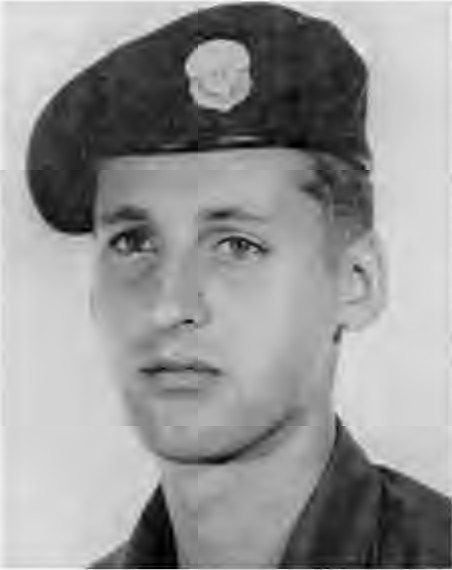
Sergeant Thomas A. Newman, a Pararescueman, was awarded the 1968 Cheney Award for his rescue of a downed F-105 pilot near Savannakhet, Laos on 30 May 1968. After Sergeant Newman was lowered into the jungle at the location of the survivor, enemy fire threatened his crew and aircraft, and Sergeant Newman requested that they evacuate.
Another HH-53 descended and lowered its hoist in the darkness. In response to a tug, the crew reeled up the hoist, but lowered it again because Sergeant Newman was caught in the coiled cable. Finally, they reeled in the Pararescueman and the downed pilot, who had a broken arm and leg. Sergeant Newman also received the Air Force Cross for his actions during this combat SAR mission.
~1967~
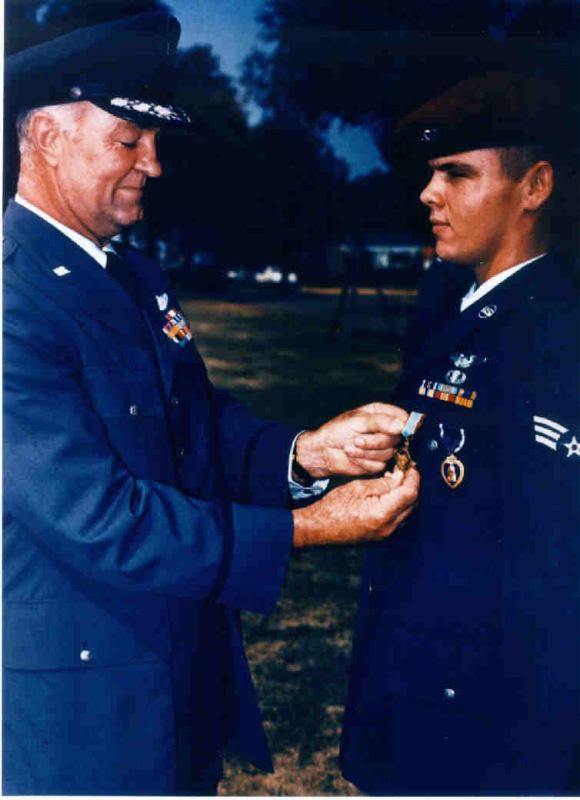 On Oct. 30, 1968, Airman 2nd Class Duane D. Hackney (June 5, 1947 - Sept. 3, 1993), a Pararescueman who received 28 decorations for valor in combat, received the 1967 Cheney Award for actions in Vietnam to save a downed pilot.
On Oct. 30, 1968, Airman 2nd Class Duane D. Hackney (June 5, 1947 - Sept. 3, 1993), a Pararescueman who received 28 decorations for valor in combat, received the 1967 Cheney Award for actions in Vietnam to save a downed pilot.
Hackney received more than 70 individual awards, and is often considered the most decorated enlisted man in Air Force history.
The Cheney Award is presented by the Air Force in memory of 1st Lt. William Cheney, who was killed in an air collision over Italy in 1918.
The award, established in 1927, is presented to an Airman for an act of valor, extreme fortitude or self-sacrifice in a humanitarian interest, performed in connection with aircraft.
~1965~
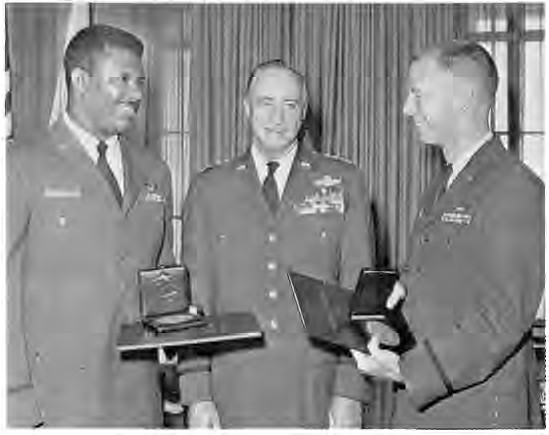
General John P. McConnell, Air Force Chief of Staff, presents the Cheney Award for 1965 to Captains James A. Darden, Jr., and Robert S. Henderson
Captains Robert S. Henderson and James A. Darden, HH-43B pilots of Detachment 10, Atlantic Air Rescue Center at Aviano AB, Aviano, Italy, received the 1965 Cheney Award. They received the award in recognition for saving the lives of 13 people on 2 and 3 September 1965, from floods in the Aviano, Italy area that caused extensive damage.
~1961~
1st Lt. William Luther was notified by a county sheriff that a 46-year-o1d woman mountain climber had fallen 40 feet from a ledge on Mt. Baher and broken her right leg near the hip. She had been lying on the mountain nearly six hours. Ground rescue teams were standing by but, because of the rugged terrain, rescue would have been an extremely lengthy operation.
Lieutenant Luther, 1st Lt. Robert Michelsen and MSgt. Lawrence Seckley, Rescue Technician; took off in an HH-43B and flew to an area approximately 75 miles from the base. After picking up the woman's son as a guide, they continued onward to the accident site and made several passes to determine if a landing could be accomplished. Since no suitable area was available, it was decided to drop off Sergeant Seckley to render any first aid possible. The woman was on the side of a 60-degree slope in a shallow crevasse under an overhanging rock ledge, a two-inch cable from an old mine was approximately 75-feet over her position.
Lieutenant Luther brought the HH-43B to a hover over the snow field near the woman's position and Sergeant Seckley jumped into the snow from one of the helicopter's bear paws. He immediately began sliding on the hard crust, unable to get a foot hold. He slid 70 feet down the mountain whose sides continued downward for another 4,000 feet to the valley floor. Finally he managed to gain a hold, but could maintain his perilous position only by not moving. Lieutenant Michelsen then climbed over the left seat to the hoist operator's position. After several attempts and many tense minutes due to the gusty wind condition and the steep incline, Sergeant Seckley managed to catch the swinging hoist lowered to him and was lifted into the helicopter.
After making this hoist pickup, it now seemed there might be a possibility to hover up to the woman and hoist her out. The aircraft was slowly inched higher up the slope into the glacial crevasse with Lieutenant Michelsen clearing Lieutenant Luther on the left as to the nearness to the rock wall and Sergeant Seckley keeping him clear of the cable overhead. The helicopter was now in a position where it could not be maneuvered any higher because of the cable, or brought further forward because of the overhanging cliff. In this position the hoist was approximately seven feet from the woman's husband, who was with her, and he couldn't reach it.
Sergeant Seckley took a coil of the hoist cable, and climbed onto the bear paw and swung the horse collar forward to the husband. The helicopter was now hovering with the blades approximately 18 to 20 inches above the overhanging cliff and 10 feet from the rock face on the left. Maintaining this hover was very difficult due to the turbulent winds blowing up and across the face of the cliff. Lieutenant Luther continually went from full left to full right rudder to hold his position at this 5,000-foot elevation.
After some difficulty, the woman was placed in the sling and Lieutenant Michelsen began slowly hoisting her up and out of the crevasse until it was noticed she still had three climbing ropes tied around her waist and secured to the rocks above her. Unsuccessful attempts were made to attract her husband's attention, but he had begun to climb back up the mountain. Sergeant Seckley then crouched down on the bear paw and managed to cut the ropes. After getting her in the door, the chopper was slowly backed out from the cliff and slid under the cable to a clear area where a 180-degree turn could be made. She was then flown to Paine AFB and a waiting ambulance.
FROM KAMAN ROTOR TIPS AUGUST 1961 COURTESY OF JOHAN RAGAY
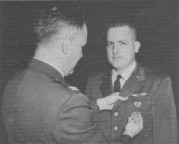
1st Lt. William A. Luther, was awarded the Air Medal by Col. Donavon F. Smith, 325th Fighter Wing Commander.
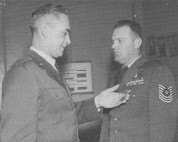
MSgt. Lawrence G. Seckley is presented the Air Medal by Col. G. W. Milholland, Deputy Commander for Operations, 325th Fighter Wing. (USAF Photo)
Two Air Medals and the Air Force Commendation Medal were awarded recently to the crew of an H-43B from McChord AFB, Wash., for the rescue of a seriously injured woman mountain climber last summer. Lieutenants Luther and Michelsen are attached to ARS Det. 5, WARC; Sergeant Seckley is a member of the 325th Operations Squadron.
Lieutenant Luther was a pilot on the hazardous flight which involved flying the H-43B below a two-inch wire cable to rescue the woman on the side of a 60-degree slope in a shallow crevasse. Lieutenant Michelsen was copilot and Sergeant Seckley, rescue technician, during the mission. A full account appears in the August, 1961 issue of Rotor Tips.

1st Lt. Robert S. Michelsen, center, received the Air Force Commendation Medal.
FROM KAMAN ROTOR TIPS APRIL 1962 COURTESY OF JOHAN RAGAY
~1959~

Captain Herbert L. Mattox, Jr., a USAF SH-19 Helicopter Pilot with the 33rd Air Rescue Squadron, was awarded the Cheney Award for a rescue in 19 October 1959, when he evacuated 29 crewmen from the Japanese vessel Zenko Maru, which had floundered on the Tori Shima reef.
~1951~
Colonel (Captain at the time) Daniel J. Miller, a USAF H-5 Helicopter Pilot with the 3rd Air Rescue Squadron, was awarded the Cheney Award for a rescue in February 1951, when he landed in deep snow and under enemy fire and rescued a total of six wounded soldiers behind United Nations lines in Korea. Captain Miller picked up two wounded in each of three attempts despite the snow and enemy fire.
From "Vietnam Air Losses" by Chris Hobson
(Courtesy of Jim Burns)
17 May 1965
F-105D 62-4222, 44th or 67th TFS, 18 TFW attached to 6234 TFW, USAF, Korat
Capt. J. U. Taliaferro (survived)
A Thunderchief was shot down by 37mm AAA while flying on an armed reconnaissance mission along Route 7 near Ban Kia Na in North Vietnam close to the Laotian border. Capt. Taliaferro ejected near the Song Ba River and landed on a hillside in dense jungle close to a village. Two USAF HH-43s soon arrived and one helicopter made the pick up as the other stood by and fighter aircraft pounded enemy positions. The helicopters flew over 200 miles across enemy territory, a feat made possible by the installation of extra drums of fuel in the cabin."
The successful rescue mission of Capt. Taliaferro resulted in all eight crew members on the HH-43s being awarded The Silver Star.

High Bird Crew
1 Lt. Walter F. Turk (AC)
Capt. Joe E. Ballinger (CP)
A1C William A. Robinson (FE)
A2C Marvin F. Brenaman (PJ)

Low Bird Crew
Capt. Bruce C. Hepp (AC)
Capt. Stanley O. Schaetzle (CP)
SSgt. Roberto Rodriguez (FE)
A2C Richard A. Wallace (PJ)
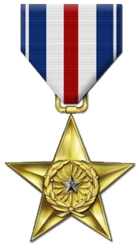
The Silver Star, as defined by law, is awarded by all branches of the armed forces to any person who, while serving in any capacity, is cited for "gallantry in action" against an enemy of the United States while engaged in military operations involving conflict with an opposing foreign force. The required gallantry, while less than that required of the Medal of Honor or Distinguished Service Cross, must nevertheless have been performed with marked distinction.

General Hunter Harris awarding the Silver Star to (LT to RT) Joe E. Ballinger, Bruce C. Hepp, Walter F. Turk, and Roberto Rodriguez
Release NO. 42-J18-671
SILVER STARS AWARDED TO EIGHT RESCUEMAN
HQ. MATS. (MSN)—Eight helicopter crewmen have been awarded Silver Stars for valor in the rescue of a downed F-105 pilot deep in North Viet-Nam. All were members of the 38th Air Rescue Squadron at Tan Son Nhut AB, Viet-Nam, (SEE NOTE) at the time of the incident last spring.
In a ceremony at 2nd Air division Headquarters in Saigon, (SEE NOTE) Gen. Hunter Harris, Commander of Pacific Air Forces, presented the nation’s third highest combat decoration to four of the men.
Two others have since been reassigned to the U. S., one is missing in action in Viet-Nam and the other completed his service tour last month.
Honored at Saigon (SEE NOTE) were Captains Bruce C. Hepp and Joe E. Ballinger, 1st Lt. Walter F. Turk and SSgt. Roberto Rodriguez.
Now in the U. S. at Hamilton AFB, Calif., are Capt. Stanley O. Schaetzle, Western Air Rescue Center, and A2C Richard A. Wallace, 41st Air Rescue Squadron. Also at Hamilton until last month was A2C Marvin F. Brenaman. Listed as missing in action as a result of a later rescue mission is A1C William A. Robinson.
In two HH-43 helicopters last May, the men flew deep into Communist North Viet-Nam to rescue Capt. James L. Taliaferro Jr., who had ejected from his crippled F-105 in the midst of a large number of enemy troops.
Piloted by Captain Hepp and Lieutenant Turk, the Huskies were equipped with extra fuel drums, making possible the 200-mile round trip. En-route, the choppers were hindered by heavy rain and clouds. They were also forced to detour around known flak positions.
Reaching the pick-up point, the Huskie crews found fighter aircraft flying rescue cover in an attempt to suppress enemy ground fire.
Captain Hepp spotted Captain Taliaferro’s orange and white parachute and also received an electronic homing beacon signal from the downed pilot. Captain Taliaferro also set off a smoke flare to help the chopper crews locate him.
“The fighters continued their suppression attacks with 20mm cannon as we descended to make the pick-up,” Captain Hepp recalls. “As we got lower Captain Schaetzie, Sergeant Rodriguez and Airman Wallace began answering enemy fire with M-16 rifles,” he added.
The heaviest enemy fire, believed to be from a .50 caliber machine gun and small arms, was coming from about 50 yards behind and below the hovering helicopter.
The second helicopter began its descent and orbited the lead chopper. As Lieutenant Turk handled the controls, Captain Ballinger, (SEE NOTE) Airman Robinson and Brenaman cut loose with M-16s at ground forces firing at them.
“It was impossible to move the chopper nearer than about 20 feet from Captain Taliaferro,” Captain Hepp recalls. “Our blades were clearing trees by five feet or less and undergrowth was brushing underneath us.” The bamboo at the scene was almost 100 feet high.
“We ran out 100 feet of hoist cable and waited for Captain Taliaferro to reach the hoist sling so we could pull him up,” Captain Hepp continued.
The downed pilot took about five minutes to reach the sling, so dense was the undergrowth. But once in the sling, he was immediately hoisted aboard the helicopter and joined his rescuers in firing at the Communist forces with his .38 revolver.
(Press release courtesy of Joe Ballinger)
NOTE: The official release is wrong in several places! No 1, the awards were made at NKP, not Tan Son Nhut as you can see by the PSP ramp and the H-3 in the background. It was reported this way to keep our cover even this late in the game! The other thing Walt and I never bothered to correct was that I was flying the high bird from the CP seat and Walt was gunning. We did this so we could fly counterclockwise around the low bird and concentrate our fire from Pilot, Flight Mech on the right side and the PJ out the back (Clamshell off).
(Joe Ballinger)
Kaman Scroll of Honor
What is the Scroll of Honor? Who is eligible? How are awards determined? William H. Weaver, KAC Awards Administrator, Customer Service deportment, supplies the answers and also explains the newly initiated "Kaman Mission Award"
 The Kaman Scroll of Honor is awarded in recognition of outstanding pilot and crew performance while conducting a rescue or mission of mercy under hazardous conditions with a Kaman helicopter. Since its inception in 1955, more than 300 military pilots and crewmen (as well as several civilians) have been awarded this honor. As most readers know, each recipient receives a framed plaque and a Scroll of Honor Rescue lapel pin. In addition, the names of the pilots are inscribed on the permanent Scroll of Honor prominently displayed at Kaman Aircraft’s Bloomfield, Conn. facility.
The Kaman Scroll of Honor is awarded in recognition of outstanding pilot and crew performance while conducting a rescue or mission of mercy under hazardous conditions with a Kaman helicopter. Since its inception in 1955, more than 300 military pilots and crewmen (as well as several civilians) have been awarded this honor. As most readers know, each recipient receives a framed plaque and a Scroll of Honor Rescue lapel pin. In addition, the names of the pilots are inscribed on the permanent Scroll of Honor prominently displayed at Kaman Aircraft’s Bloomfield, Conn. facility.
Attaining a place on the Scroll of Honor is not a routine accomplishment, for the Scroll was originated with the express purpose of paying homage to those men who have performed outstanding missions. Participation in a rescue or mission of mercy is not, by itself, sufficient qualification since such a mission is considered to be the fulfillment of one of the primary roles for which the pilot and crew were trained.
More specifically, a review board at Kaman appraises each mission nominated for the Award in terms of certain criteria. First of all, the mission must be a rescue mission or mission of mercy. In addition, the mission must call for an "unusually high degree of skill, courage and judgment" on the part of the pilot and crew while operating under difficult or hazardous conditions. In determining if accomplishment of a given mission qualifies for the Scroll of Honor, the review board takes into consideration many factors, among which are the following: night or restricted visibility en route; difficult or hazardous terrain en route; hovering with rotor blades in close proximity to trees, terrain, buildings, or other obstacles; required doppler approach to hover; extreme altitude and/or temperature where pilot technique and procedures are paramount; unusual weather conditions including high winds or severe wind gusts. The copilot will also be awarded the pilot Scroll when it is determined that he was as necessary to the success of the mission as was the pilot. Crew members, of course, will receive the crew Scroll on qualifying missions.
Kaman Aircraft has now instituted a new award called a "Kaman Mission Award" in recognition of the humanitarian service performed when any rescues or missions of mercy are accomplished. Effective July 1st, 1964 pilots and crew members participating in a routine rescue or mission of mercy will be eligible to receive a Kaman Mission Award which verifies that the named individual "has served meritoriously in a Kaman helicopter participating on a mission of mercy." Upon qualifying for this Award, the nominee will receive a plasticized wallet certificate, a rescue pin, and a place on the Kaman Mission Award list.
Nominations for either the Kaman Mission Award or the Kaman Scroll of Honor can be made through a Kaman Service Representative, the Commanding Officer, or by writing to the Director of Customer Service, Kaman Aircraft Corp., Old Windsor Road, Bloomfield, Conn. To insure an adequate and comprehensive review, complete details of the mission must accompany each recommendation for an award.
A Very Special USAF ROTORHEADS thanks to Johan Ragay for providing the information on this page. Johan was kind enough to go through the many issues of the Kaman "Rotor Tips" and extract this valuable part of our helicopter history.
Kaman Rotor Tips (1970) | Kaman Rotor Tips (1972) | Kaman Rescue Pins

Integrity, Honor, and Respect
Some of the best things cannot be bought, they must be earned
©2023 USAF Rotorheads All Rights Reserved | Financial Statement
